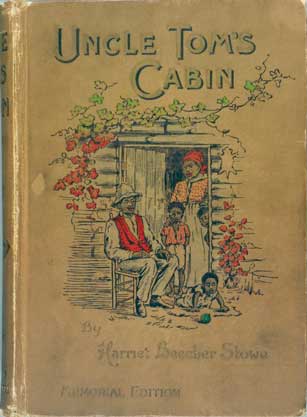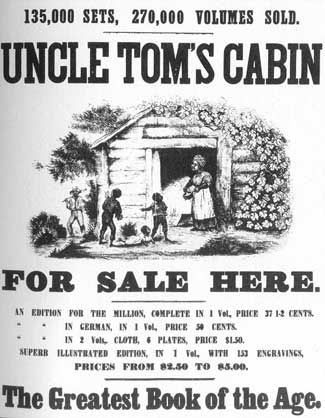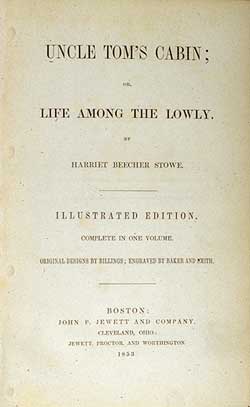'It Was Promoted As A Book That Deserved To Be Read'
Anatomy Of An Early American Bestseller
By Michael Winship
Michael Winship, Iris Howard Regents Professor of English II at the University of Texas at Austin, is the author of American Literary Publishing in the Mid-Nineteenth Century (1995) and a member of the editorial board of and contributor to multiple volumes of A History of the Book in America series, now published by the University of North Carolina Press. The following essay, published online at Common-Place, is an excerpt of a longer essay, "Two Early American Bestsellers," which itself is an update of an early version presented as a keynote address at "Birth of the Bestseller: The 19th-Century Book in Britain, France, and Beyond," organized by the Bibliographical Society of America in New York in March 2007. In this essay, Professor Winship contrasts the publishing histories of Susanna Haswell Rowson's Charlotte Temple and Harriet Beecher Stowe's Uncle Tom's Cabin, both of which achieved substantial sales, but had strikingly different sales patterns. The portion reprinted here focuses solely on Uncle Tom’s Cabin's path to bestseller status.
Uncle Tom's Cabin is widely recognized as the great American bestseller of the nineteenth century--the "greatest book of its kind" as its original publisher styled it. Written by Harriet Beecher Stowe, the daughter of the leading American evangelical of the time and wife of one of our first biblical scholars, the novel was her impassioned response to the enactment of the Fugitive Slave Act of 1850, which implicated all Americans, both northern and southern, in support of the moral outrage of chattel slavery. Stowe, who had been supplementing her family income by publishing stories and sketches since the 1830s, was regularly contributing material to the moderate antislavery National Era in March 1851, when she wrote to its editor, Gamaliel Bailey, announcing that she was at work on a story that addressed the evils of slavery. Initially she expected that it would extend to only three or four installments, but eventually the text of Uncle Tom's Cabin expanded to make up many more, which were published weekly from June 6, 1851, to April 1, 1852. The work attracted a considerable following as a serial, but not until its publication in book form would it truly become a bestseller.
As early as summer 1851, discussions were underway for the publication of Uncle Tom's Cabin in book form, but Boston's Phillips, Sampson, and Company, the firm originally approached, declined to take it on, fearing that its antislavery content would alienate the southern market. In September, Bailey announced in the National Era that he had learned from a private source that Stowe had completed arrangements with another Boston firm, John P. Jewett and Company. In fact, the contract with Jewett was not signed until March 13, 1852, a week before the book finally appeared and twelve days before the text was completed in the National Era. The first edition of Uncle Tom's Cabin was published March 20, 1852, in two volumes priced $1.00, $1.50, or $2.00, depending on the binding.
From the start, the book was a hit. The first printing of five thousand copies was exhausted in a few days, and by April 1, a second run of five thousand had been produced. In mid-April, Jewett announced that ten thousand copies had been sold and that "three paper mills are constantly at work, manufacturing the paper, and three power presses are working twenty-four hours per day, in printing it, and more than one hundred book-binders are incessantly plying their trade to bind them, and still it has been impossible, as yet, to supply the demand." By mid-May fifty thousand copies had been sold, seventy-five thousand copies by mid-September, and in mid-October one hundred and twenty-five thousand were claimed. For the 1852 holiday season, Jewett produced two further editions: three thousand copies of an expensive one-volume gift edition with over one hundred vignette illustrations, costing $2.50 to $5.00 depending on the binding, and an inexpensive "edition for the millions," selling for only thirty-seven and a half cents, of which fifty thousand had been produced by year's end.
All this made Stowe wealthy--Jewett paid her over twenty thousand dollars in royalties by the end of 1852--and world renowned. The first London edition of Uncle Tom's Cabin appeared in late April or early May, and the work was reported to have sold over one million copies in various British editions before year's end. It was soon also reprinted, in both English and translation, on the European continent and around the world. But the Uncle Tom phenomenon extended beyond the novel to offshoots-children's versions, sheet music, figurines, games, muslin handkerchiefs, among others-not to mention a multitude of responses, known as "Anti-Uncle Tom" novels, which attempted to counter the work's antislavery sentiments. In the United States, dramatizations of Uncle Tom's Cabin became a staple of American melodrama well into the twentieth century.
A bestseller? Certainly. Less widely recognized is that the market for the original text of Uncle Tom's Cabin soon dried up in the United States. Jewett produced something like three hundred and ten thousand copies of the work during its first year of publication, but subsequent demand remained small for many years. Forced to suspend payment of his debts during the panic of 1857, Jewett produced another small printing in late 1859, shortly before he finally left the publishing business entirely in August 1860. The rights to Uncle Tom's Cabin were then acquired by another Boston publisher, Ticknor and Fields, which first published a small printing of only two hundred seventy copies in November 1862. During the 1860s, that firm and its successors produced just under eight thousand copies. But sales were increasing: during the 1870s, nearly twenty thousand copies were produced, and during the five-year period from 1886 to 1890 just under one hundred and ten thousand copies. By the time that Uncle Tom's Cabin entered the public domain in 1893, the work had, like Charlotte Temple, become a steady seller. Houghton, Mifflin, and Company, the firm that had inherited the rights to the work from Ticknor and Fields, made a determined attempt to maintain its control of the market for the work by issuing a variety of editions, from cheap to expensive, but by the turn of the century, Uncle Tom's Cabin was being published by a veritable array of American publishers of inexpensive books: Altemus, Burt, Caldwell, Coates, Crowell, Dominion, Donohue, Fenno, Hill, Hurst, Lupton, McKay, Mershon, Neeley, Page, People, Rand, Routledge, Warne, and Ziegler.
(left) Title page from the first edition of Uncle Tom's Cabin; or, Life Among The Lowly, by Harriet Beecher Stowe (Boston; Cleveland, Ohio, 1852). Courtesy of the American Antiquarian Society, Worcester, Massachusetts.(right) Title page from the holiday gift edition of Uncle Tom's Cabin; or, Life Among The Lowly, by Harriet Beecher Stowe (Boston; Cleveland, Ohio, 1853). Courtesy of the American Antiquarian Society, Worcester, Massachusetts.
The initial success of Uncle Tom's Cabin was no doubt due, in part, to its topicality: the Fugitive Slave Act meant that no American could ignore the implications of slavery any longer. Stowe's depiction of that "peculiar institution" stressed not only its cruelty but also the ways in which it compromised the values of Christianity and domesticity that were so much a part of the dominant culture of Victorian middle-class America. The promotional activities of its publisher J. P. Jewett also played a role. Jewett was recognized by his contemporaries as an innovative book promoter at a time when a truly national market for books was first established in the United States. His successes included not only Uncle Tom's Cabin but also the second great bestselling domestic novel of the decade--The Lamplighter (1855) by Susanna Cummins. In promoting Uncle Tom's Cabin, Jewett spent thousands of dollars for advertising before the work was published, and upon its publication he traveled to Washington to push the book to all leading senators, both northern and southern, a tactic that surely served to draw attention to it. Front matter added to the new 1878 edition of Uncle Tom's Cabin made sure to stress that this was a work that championed the downtrodden, now generalized over ten years after the emancipation of the African American slaves, but also the work's status as an American classic that had been recognized worldwide. It was promoted as a book that deserved to be read.
Uncle Tom's Cabin achieved a remarkable sale immediately upon publication in book form, something that struck contemporaries as extraordinary. But its sale ceased almost completely after a year, for production came to a halt, and only after several decades did Stowe's work begin to find an audience that brought it steady sales. Perhaps the very fact that the work was controlled under copyright encouraged J. P. Jewett to make such promotional efforts when the book was first published to ensure its exceptional success. Nevertheless, it is also worth noting that Uncle Tom's Cabin achieved remarkable sales in Britain, where it was not protected by copyright, and in the United States, especially after 1893, when it had entered the public domain.
Founder/Publisher/Editor: David McGee
Contributing Editors: Billy Altman, Laura Fissinger, Christopher Hill, Derk Richardson
Logo Design: John Mendelsohn (www.johnmendelsohn.com)
Website Design: Kieran McGee (www.kieranmcgee.com)
Staff Photographers: Audrey Harrod (Louisville, KY; www.flickr.com/audreyharrod), Alicia Zappier (New York)
E-mail: [email protected]
Mailing Address: David McGee, 201 W. 85 St.—5B, New York, NY 10024






